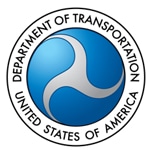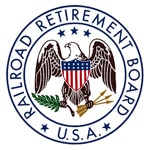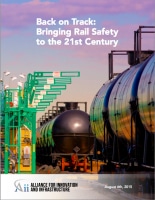At a nomination hearing September 17, 2015, before the Senate’s Committee on Commerce, Science, and Transportation, the Federal Railroad Administration’s (FRA) Acting Administrator Sarah Feinberg testified on her qualifications as Administrator. Below is her speech.
“Chairman Thune, Ranking Member Nelson, and Members of the Committee, thank you for the opportunity to appear before you today. Senator Manchin, thank you for your kind introduction. I am grateful for your friendship, your decades of service to our home state, and your strong support.
“I’ll just briefly note that I’m so pleased that my brothers, David and Matthew, are here with me, and other members of my family are with me in spirit.
“It is an honor to have been nominated by President Obama to serve as the Administrator for the Federal Railroad Administration and to have earned the confidence of Secretary Foxx. It is also a great responsibility, one that I take seriously.
“Just one month after I became Acting Administrator, a Metro-North train traveling out of New York City with hundreds of passengers hit a car at a grade-crossing. Six people were killed doing what millions of Americans do every day: traveling home from work; visiting friends; on the way to see family.
“Days later, in Senator Manchin’s and my home state of West Virginia, a mile-and-a-half long train carrying 109 tank cars loaded with crude oil derailed near the town of Montgomery. One person was injured; multiple small communities were evacuated; a fire burned for days. And anyone who visited the scene would agree: we got lucky.
“In May, an Amtrak train traveling significantly over the speed limit derailed in Philadelphia. The horrific accident took the lives of eight people—again, men and women simply closing out an evening commute and heading home to see their families.
“These accidents are searing reminders that millions of Americans depend on railroads, and FRA’s diligent oversight, to transport them safely to their jobs each morning, to their homes and families each night, and to deliver goods and products safely every day.
“Next year, FRA will be a half-century old. The agency has a proud history and a long list of accomplishments, most notably its significant contributions in recent years to improving rail safety. Rail deaths and injuries are down dramatically, worker injuries are down, derailments and incidents are down. And those decreases are very much a testament to the work of the men and women of FRA and the rail industry too.
“But, in many ways, safety in the rail industry has plateaued. Improvements are generally not as dramatic as they used to be, and we occasionally even see spikes in the wrong direction. That calls for action.
“The American people expect every federal agency to adapt to new conditions and new realities, to be willing to change, to be open to criticism. Over the last eight months, that is what FRA has done – willing to respond to new leadership, and a new direction. Along the way, we found new solutions to old challenges.
“We have tried new solutions to end the old challenge of grade crossings accidents and fatalities. We partnered with police around the country to step up enforcement. And, in June, Google agreed to integrate our grade crossing data to add audio and visual alerts on Google maps, marking the first time the agency has partnered with a technology company.
“We have taken a new approach to the way we handle old NTSB recommendations. When I arrived at FRA in January, there were more than 70 NTSB recommendations awaiting action. With new determination, we have taken action on more than half of them – reducing the number of outstanding recommendations by nearly 15 percent. Some of these recommendations had been sitting for at least five years. Today, we await word back from the NTSB on another 30. I will not be satisfied until each recommendation is acted upon, implemented, or at the very least responded to.
“We’ve also been looking for new solutions when it comes to our financing programs.
“FRA listened to the frustrations that many members of this committee expressed about the Railroad Rehabilitation & Improvement Financing (RRIF) program, and we’ve acted.
“With more staff and greater attention, we made the program stronger and faster. This year, we have already completed two and expect to complete two more soon. You have my word: the RRIF program is open for business.
“While working to try to bring new solutions to these old challenges, we’ve also stayed focused on our ongoing priorities. The men and women of FRA have spent much of 2015 delivering significant results on those priorities.
“With our sister agency, the Pipeline and Hazardous Materials Safety Administration, we completed the High Hazard Flammable Train rule. Since the crude oil train derailment in Lac-Mégantic, Canada, two years ago, the United States has seen more than a dozen crude oil train derailments of our own. In May, the Department of Transportation issued a final, comprehensive rule that aims to prevent these types of accidents—and lessens their impact if they do occur.
“We’ve prioritized PTC implementation – hiring staff and creating a task force that reports to me regularly on progress and the performance of each railroad. We were also proud to work with many here today and in the greater New York City region to provide a nearly $1 billion loan to implement Positive Train Control on MTA’s system.
“Both the Administration’s budget and its GROW AMERICA Act have requested significant funding to assist commuter railroads on PTC installation. Chairman Thune, I want to thank you and members of this committee, in particular, for the recently passed legislation that seeks to leverage $200 million to cover some of the costs and expenses railroads face when taking out a RRIF loan to implement PTC.
“All this activity is in addition to our continued focus on making sure the agency’s partners deliver High Speed Intercity Passenger Rail projects for the American people.
“We continue to closely monitor the funding that Congress invested across the country to provide faster, more frequent and more reliable passenger rail service.
“None of this success would have been possible without the tireless work of the nearly 900 public servants at the agency who are dedicated to rail safety. It’s been my honor to lead them as Acting Administrator.
“Chairman Thune and Ranking Member Nelson, I am pushing FRA each day to be vigilant in the pursuit of safety, and open to paths to innovation from any source. The agency is engaged, enthusiastic, and driven, because we know the gravity of our responsibilities and the size of our opportunities. A safe rail system is a strong rail system. And our country continues to need rail to build its future.
“If confirmed, I would eagerly work with all members of this committee and all members of Congress to build a stronger and safer rail system. One we can all be proud of.
“Thank you Mr. Chairman, and members of the Committee, and I look forward to your questions.”

 Washington – The Occupational Safety and Health Administration is extending the deadline for submitting comments on the
Washington – The Occupational Safety and Health Administration is extending the deadline for submitting comments on the  Washington – The White House Office of Management and Budget, Council on Environmental Quality, and U.S. Department of Transportation announced new actions by the Obama Administration to accelerate the Nation’s critical infrastructure projects, including an enhanced Federal Infrastructure Permitting Dashboard, new guidance to Federal agencies establishing metrics for the permitting and environmental review of infrastructure projects, and the first update in nearly 30 years to the Synchronizing Environmental Reviews for Transportation and Other Infrastructure Projects handbook (known as the Red Book) – an interagency effort spearheaded by the U.S. Army Corps of Engineers.
Washington – The White House Office of Management and Budget, Council on Environmental Quality, and U.S. Department of Transportation announced new actions by the Obama Administration to accelerate the Nation’s critical infrastructure projects, including an enhanced Federal Infrastructure Permitting Dashboard, new guidance to Federal agencies establishing metrics for the permitting and environmental review of infrastructure projects, and the first update in nearly 30 years to the Synchronizing Environmental Reviews for Transportation and Other Infrastructure Projects handbook (known as the Red Book) – an interagency effort spearheaded by the U.S. Army Corps of Engineers. As part of these efforts, Federal agencies previously expedited the review and permitting of over 50 major infrastructure projects, including bridges, transit, railways, waterways, roads, and renewable energy projects, employing common sense practices like running different reviews concurrently rather than sequentially, and using the Administration’s online Dashboard to promote accountability for a shared schedule. Over half of those projects have completed the permitting process, yielding notable successes like the permitting of the Tappan Zee Bridge in just a year and a half. The Administration’s 2014 comprehensive plan offered recommendations to expand on those initial projects, and today’s actions fulfill several key recommendations from that plan.
As part of these efforts, Federal agencies previously expedited the review and permitting of over 50 major infrastructure projects, including bridges, transit, railways, waterways, roads, and renewable energy projects, employing common sense practices like running different reviews concurrently rather than sequentially, and using the Administration’s online Dashboard to promote accountability for a shared schedule. Over half of those projects have completed the permitting process, yielding notable successes like the permitting of the Tappan Zee Bridge in just a year and a half. The Administration’s 2014 comprehensive plan offered recommendations to expand on those initial projects, and today’s actions fulfill several key recommendations from that plan. Days after the Republican presidential candidate Scott Walker announced his plan to get rid of the National Labor Relations Board, Democratic lawmakers are rolling out a plan to strengthen the government agency. The bill, introduced on Wednesday, will also serve as a litmus test to Democrats vying for union endorsements in the 2016 presidential election.
Days after the Republican presidential candidate Scott Walker announced his plan to get rid of the National Labor Relations Board, Democratic lawmakers are rolling out a plan to strengthen the government agency. The bill, introduced on Wednesday, will also serve as a litmus test to Democrats vying for union endorsements in the 2016 presidential election.
 Beginning in 2002, a significant portion of the assets of the Railroad Retirement Board (RRB) has been invested in private stocks, bonds, and other investments. Prior to the Railroad Retirement and Survivors’ Improvement Act of 2001, P.L. 107-90, surplus railroad retirement assets could only be invested in U.S. government securities— just as the Social Security trust funds must be invested. The 2001 act established the National Railroad Retirement Investment Trust (NRRIT; hereinafter, the Trust) to manage and invest part of the RRB’s assets in the same way that the assets of private-sector and most state and local government pension plans are invested. The remainder of RRB’s assets continues to be invested solely in U.S. government securities.
Beginning in 2002, a significant portion of the assets of the Railroad Retirement Board (RRB) has been invested in private stocks, bonds, and other investments. Prior to the Railroad Retirement and Survivors’ Improvement Act of 2001, P.L. 107-90, surplus railroad retirement assets could only be invested in U.S. government securities— just as the Social Security trust funds must be invested. The 2001 act established the National Railroad Retirement Investment Trust (NRRIT; hereinafter, the Trust) to manage and invest part of the RRB’s assets in the same way that the assets of private-sector and most state and local government pension plans are invested. The remainder of RRB’s assets continues to be invested solely in U.S. government securities.
